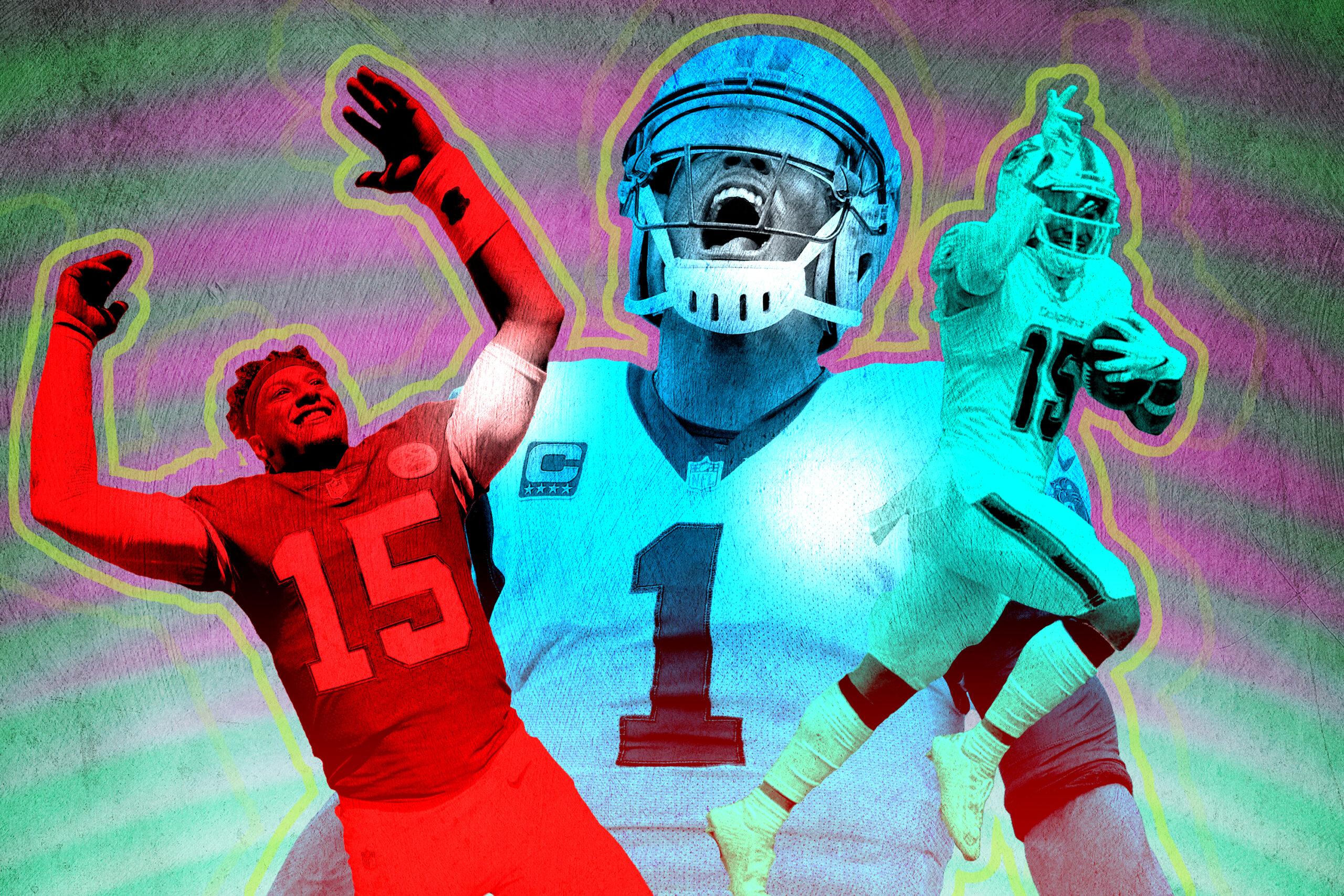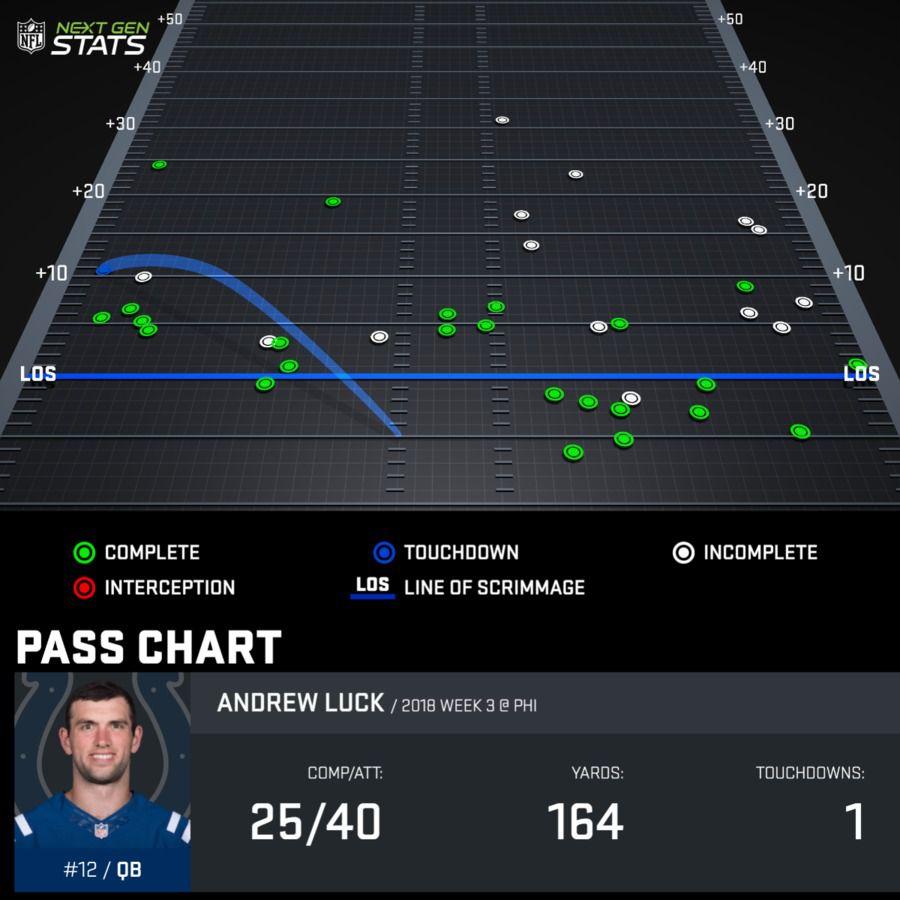
Another wild NFL Sunday is in the books. For the third straight week, we got a sprinkling of unbelievable outcomes to go with a handful of exciting, back-and-forth battles: The Bills, who came into the week looking like the clear-cut worst team in the NFL (and as 16.5-point underdogs), dominated the über-talented Vikings on both sides of the ball in a 27-6 win. The Titans, with zero healthy quarterbacks, scored nine points ... and still beat the AFC powerhouse Jacksonville Jaguars. The Patrick Mahomes II–led Chiefs offense held off the 49ers, the Redskins knocked off the Packers, the Falcons and Saints traded the lead nine times in a barn-burning overtime New Orleans win, and the Panthers outlasted the Bengals 31-21. The weekend slate featured nonstop action, but some moments were more pivotal than the rest. Here are a few of the biggest game-changing plays from Sunday’s action, along with what they can tell us about both the teams involved and the season at large.
Cam Newton Scores on a QB Keeper
Leading the Bengals 21-14 with 5:39 to go in the third quarter, the Panthers turned to an old, reliable red zone staple to get into the end zone and effectively seal themselves a win. Running behind pulling guard Greg Van Roten, quarterback Cam Newton kept the ball on a zone-read option play, weaving effortlessly through traffic before bulldozing through a defender to reach pay dirt.
That 5-yard dive gave Carolina a commanding 28-14 lead and pushed its win probability to a near-lock at 92.2 percent, according to numberFire’s model. That was Newton’s second rushing touchdown of the day—a demoralizing dagger for the Bengals defense that was emblematic of a theme that’s emerged for the Panthers over the first three weeks of the season: letting Newton be Newton.
Gone is all that talk of limiting carries, like we heard from Ron Rivera during the 2017 offseason. Newton scoffed at that idea at the time, stating that his ability to run is his “edge,” while adding, “Are you really going to expect a lion not to roar?” Carolina didn’t live up to Rivera’s stated goal, as Newton went on to rack up career highs in rush attempts (139) and yards (756) and scored six touchdowns with his legs last year. And this season, with new offensive coordinator Norv Turner at the helm, the Panthers seem to have fully re-embraced the fact they have a transcendent, unique dual-threat quarterback as the focal point of their offense.
The season’s young, but Newton’s on pace for a career high in rushes (9.3 per game), isn’t far off his career pace in yards (725), and, with three rushing touchdowns in three games, is off to a 16-score pace as a runner, which would surpass the NFL record he set as a rookie (14). Projecting season-long numbers off a three-game sample is often foolhardy, but it wouldn’t be surprising if Newton’s pace never slows. His combination of size, explosiveness in the open field, and pure power—paired with the mathematical advantage that option football creates—makes him damn-near unstoppable as a runner. Last season Newton led all quarterbacks in read-option yards per attempt (14.6, 4-plus yards more than anyone else). That play, along with quarterback power runs, quarterback draws, the triple option, and the entire catalog of Carolina’s QB-run menu makes him perhaps the most dangerous red zone player—ever. That might sound hyperbolic, but consider this: After adding two more TDs Sunday, Newton has 57 career rushing scores, which places him second among all players since he came into the league in 2011. Oh, and he can throw the ball, too.
With help from running back Christian McCaffrey (who’s averaged 143 scrimmage yards a game this year) and receiver Devin Funchess (14 catches, 185 yards, one touchdown on the season), Newton’s on pace for career highs in passer rating (99.7) and completion percentage (67.4). Most importantly, he’s been consistent week to week. Newton looks to be in command of the Panthers offense in a way that we haven’t seen since his 2015 MVP season.
Patrick Mahomes II Throws a Touchdown to Sammy Watkins
The Chiefs remind me a little bit of peak Mike Tyson: In each of their first three games, they’ve come out at the proverbial opening bell throwing a flurry of haymakers. In Week 1, the Chiefs built an early 14-3 lead on the Chargers. In Week 2, they jumped all over the Steelers, running out to a 21-0 lead. And Sunday, they had the Niners on the ropes before the end of the first half as they built a commanding 35-7 second-quarter lead that included this play, a 12-yard catch and run by Watkins. It gave the Chiefs a 99.2 percent win probability.
That play probably should’ve been the de facto knockout blow for the Chiefs, but San Francisco kept fighting. Like the Steelers last week (who battled back to tie the game at 21 at the half before succumbing to Mahomes’s power), the 49ers made things interesting as the game went on, cutting the lead to just 11 late in the third quarter. After Jimmy Garoppolo left the game with a knee injury, backup C.J. Beathard tossed a 7-yard touchdown pass to tight end George Kittle that would’ve cut the lead to seven with 5:27 to go if it hadn’t been called back on a questionable offensive pass interference penalty. The Niners opted for the field goal, and that’s as close as they got to the Chiefs, who ran out the final 5:12 to preserve the 38-27 win.
That type of game flow—jump out to a big early lead then hold off the comeback in the second half—could end up being an every-week occurrence for Kansas City this season (and the whole start-hot-then-fade pattern might be a little too fitting for an Andy Reid–coached team). With Mahomes under center, the Chiefs offense is an absolute buzz saw. But their defense is one of the league’s worst: Through three weeks (and prior to Monday night’s matchup between the Steelers and Buccaneers), Kansas City’s given up a league-worst 474 yards a game, 6.7 yards per play, and 30.6 points per game (both third worst). Right now, the Chiefs look like the team to beat in the AFC, but unless they get more from their porous defense, they’re going to need Mahomes to keep up his torrid early-season pace. Then again, with the way that Mahomes has played thus far, that might not be a problem.
Jared Goff Hits Robert Woods for a TD
Over the first two weeks of the season, the Rams offense was nearly as impressive as the Chiefs offense, leading the league in yards per drive and drive success rate while ranking second behind K.C. in points per drive. But where the two teams differed was on defense, and L.A.’s star-studded group had given its offense a nice security net, holding the Raiders to 13 points in the opener and shutting out the Cardinals in Week 2.
Sunday, Jared Goff and Co. got a little taste of what Mahomes goes through each week. With cornerbacks Marcus Peters and Aqib Talib on the bench nursing leg injuries, the Chargers’ top-flight offense pounced: They chipped away at the Rams’ early 21-6 lead with a Melvin Gordon touchdown just prior to the half, then cut the subsequent 28-13 lead to eight with a 20-yard touchdown strike from Philip Rivers to Mike Williams.
But Sean McVay’s group kept the pedal to the metal, orchestrating a 12-play, 77-yard drive on their next possession, capping it with this 6-yard TD strike to Robert Woods.
That pushed the Rams’ win probability to 95.5 percent and served as the final blow to the Chargers’ comeback hopes. On the drive, Goff completed passes to Woods, Todd Gurley, and Brandin Cooks, methodically moving the ball down the field while eating up nearly five minutes of third-quarter clock. A lot of teams might tighten up in that situation, but the Rams just kept doing what they’ve done all year, sealing the win to move to 3-0. In the game, they racked up 521 yards, 33 first downs (tied for most by any team this year), and went 8-of-11 on third down. They’ve now got an NFL-best plus-66 scoring margin, and if that doesn’t adequately paint a picture of an offensive machine that chews up and spits out opposing defenses, this might:
Matt Milano Picks Off Kirk Cousins
For Vikings fans hoping for a second-half comeback—or for everyone else expecting a Bills second-half meltdown—this play all but put those thoughts to bed. Milano’s interception at the 9:30 mark of the third quarter was a good microcosm of Buffalo’s remarkable day on that side of the ball: Defensive end Eddie Yarbrough brought pressure off the edge, forcing Cousins to get rid of the ball quickly and into coverage. The pass got to running back Latavius Murray just as he was sandwiched by Milano and Tremaine Edmunds, popping the ball free and into the waiting lap of the Bills linebacker.
That play was the final nail in the Vikings’ coffin, pushing Buffalo’s win probability to 95.6 percent. After coming into the week 30th in defensive DVOA and tied for last in points allowed, Buffalo’s defense held Cousins to 5.4 yards per attempt, forced three fumbles (recovering two), and racked up three sacks, five quarterback hits, and 10 passes defended.
The biggest story of the day might be that rookie quarterback Josh Allen looked more than competent against one of the most talent-packed defenses in the NFL, but the way the Bills defense performed was almost as shocking. It swarmed to the ball. It out-hit their opponent. It got its hands into passing lanes. It made big plays. It looked nothing like the unit we saw in the first two weeks. The NFL is so weird.
But the Bills’ sudden about-face on defense might be more than just a fluke. After head coach Sean McDermott took play-calling duties away from Leslie Frazier in the second half of the Bills’ loss to the Chargers last week, Frazier responded on Sunday by dialing up a much more aggressive game plan, pumping energy into a lethargic group and unlocking some of its playmakers. Veteran pass rusher Jerry Hughes came alive, grabbing a sack, two QB hits, and a forced fumble. Defensive tackle Kyle Williams grabbed a sack of his own. Safety Micah Hyde and cornerback Tre’Davious White each knocked down a pass, and rookie first-round linebacker Tremaine Edmunds racked up a team-high 10 tackles. The Bills defense was never as bad as it looked during the first two weeks of the season, and its performance Sunday resuscitates what had looked like a lost season.
Albert Wilson Scores 74-Yard Touchdown on a Sweep
With a Xavien Howard end zone pick, the Dolphins took back the ball with 2:54 left in the fourth quarter holding a slim 21-17 lead over the visiting Raiders. Head coach Adam Gase’s goal at that point, I assume, was to salt away the rest of the clock with a chains-moving, game-ending drive. Instead, following a 6-yard run by Frank Gore to open the possession, this happened:
In a fly-sweep motion before the snap, Wilson took this “pass” around the corner and downfield for 74 yards untouched (apart from a high five from his teammate Jakeem Grant at the 15-yard line), pushing the Dolphins’ lead to 11 and effectively sealing the win.
That play put a bow on an unexpected offensive performance in which Gase reached a little deeper into the playbook and pulled out some looks that stressed the Raiders defense and showcased the talents of some of his most explosive athletes. Grant had scored on a mirror image of that same play late in the third quarter, in fact:
And midway through the fourth, Gase dialed up the Dolphins’ version of the Philly Philly, the Philly Special variation that the Eagles ran in Week 1. Quarterback Ryan Tannehill took the snap and handed the ball to Gore, who tossed it to Wilson as he ran what looked to be an end-around play and then threw downfield to a streaking Grant for the touchdown.
As offenses spread out and seek to create mismatches in space, speed is an increasingly important factor in the modern NFL; just look at the Chiefs’ record-setting group. Well, the Dolphins have quietly assembled an explosive group of their own. Wilson registered an NFL-best top speed of 21.74 miles per hour on that 74-yard touchdown scamper, and that open-field prowess is why Miami signed him over the offseason. The former Chief finished tied for third among receivers last year in forced missed tackles after a reception (15), per Pro Football Focus, and averaged 7.5 yards after the catch (second). Since coming into the NFL in 2014, he ranks first among all wide receivers in missed tackles forced per reception. Grant, meanwhile, might be one of the fastest players in the league. He ran a 4.38 at his pro day in 2016, and the 5-foot-7, 169-pound dynamo brings the ability to score from anywhere on the field on any given play. Add in deep threat Kenny Stills, running backs Kenyan Drake and Kalen Ballage, and tight end Mike Gesicki—all of whom came into the league with elite athletic profiles—and the Dolphins offense has speed to burn. More importantly, Gase seems to be figuring out how to exploit it.
At 3-0, the Dolphins and sit atop the AFC East. They’re 10-1 in Tannehill’s last 11 starts, dating back to 2016. Oh, and the defense, which led the NFL in opponent passer rating coming into the week, might not be as bad as people think either.
Jacoby Brissett Throws Incomplete on Hail Mary Into End Zone
The fact the Colts brought their strong-armed backup quarterback into the game to toss up a failed last-second bomb isn’t an indictment of Andrew Luck in 2018 and beyond. But it does drive home the idea that Indianapolis is going to continue to handle Luck’s surgically repaired shoulder with kid gloves—and that a dink-and-dunk offense appears to be the new normal.
In the Colts’ 20-16 loss to the Eagles, Luck completed 25 of 40 passes for 164 yards (4.1 yards per attempt) and one touchdown. That wasn’t much different than what we saw in weeks 1 and 2, and, on the year, Luck’s average intended air yards sit at 5.5 per throw, the second shortest leaguewide, while his average completed air yards per throw (3.4) is tied for the NFL low. Here’s what that pass offense looked like Sunday, from NFL Next Gen Stats:

The lack of a vertical element isn’t exactly a death sentence. Coming into this week, Indianapolis ranked third in plays per drive (6.62) and eighth in points per drive, according to Football Outsiders. But Sunday, the Colts managed just 209 total yards and went 2-for-12 on third down. In the long run, the dink-and-dunk style could put a bigger burden on both Luck and his receivers, backs, and linemen to execute play to play and drive by drive. It’s not easy to put together the types of 10-play scoring drives that style of play might require.
An earlier version of this piece incorrectly stated that Bills defensive coordinator Leslie Frazier was not calling defensive plays on Sunday. Frazier had his play-calling duties reinstated this week after having them stripped in Week 2.

